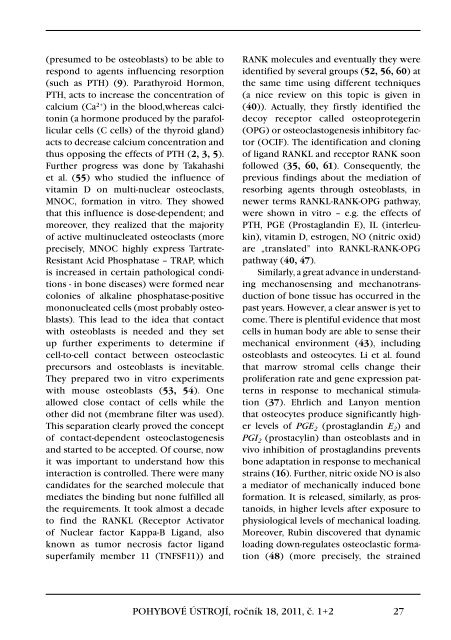1+2/2011 - SpoleÄnost pro pojivové tkánÄ›
1+2/2011 - SpoleÄnost pro pojivové tkánÄ›
1+2/2011 - SpoleÄnost pro pojivové tkánÄ›
- No tags were found...
Create successful ePaper yourself
Turn your PDF publications into a flip-book with our unique Google optimized e-Paper software.
(presumed to be osteoblasts) to be able torespond to agents influencing resorption(such as PTH) (9). Parathyroid Hormon,PTH, acts to increase the concentration ofcalcium (Ca 2+ ) in the blood,whereas calcitonin(a hormone <strong>pro</strong>duced by the parafollicularcells (C cells) of the thyroid gland)acts to decrease calcium concentration andthus opposing the effects of PTH (2, 3, 5).Further <strong>pro</strong>gress was done by Takahashiet al. (55) who studied the influence ofvitamin D on multi-nuclear osteoclasts,MNOC, formation in vitro. They showedthat this influence is dose-dependent; andmoreover, they realized that the majorityof active multinucleated osteoclasts (moreprecisely, MNOC highly express Tartrate-Resistant Acid Phosphatase – TRAP, whichis increased in certain pathological conditions- in bone diseases) were formed nearcolonies of alkaline phosphatase-positivemononucleated cells (most <strong>pro</strong>bably osteoblasts).This lead to the idea that contactwith osteoblasts is needed and they setup further experiments to determine ifcell-to-cell contact between osteoclasticprecursors and osteoblasts is inevitable.They prepared two in vitro experimentswith mouse osteoblasts (53, 54). Oneallowed close contact of cells while theother did not (membrane filter was used).This separation clearly <strong>pro</strong>ved the conceptof contact-dependent osteoclastogenesisand started to be accepted. Of course, nowit was important to understand how thisinteraction is controlled. There were manycandidates for the searched molecule thatmediates the binding but none fulfilled allthe requirements. It took almost a decadeto find the RANKL (Receptor Activatorof Nuclear factor Kappa-B Ligand, alsoknown as tumor necrosis factor ligandsuperfamily member 11 (TNFSF11)) andRANK molecules and eventually they wereidentified by several groups (52, 56, 60) atthe same time using different techniques(a nice review on this topic is given in(40)). Actually, they firstly identified thedecoy receptor called osteo<strong>pro</strong>tegerin(OPG) or osteoclastogenesis inhibitory factor(OCIF). The identification and cloningof ligand RANKL and receptor RANK soonfollowed (35, 60, 61). Consequently, theprevious findings about the mediation ofresorbing agents through osteoblasts, innewer terms RANKL-RANK-OPG pathway,were shown in vitro – e.g. the effects ofPTH, PGE (Prostaglandin E), IL (interleukin),vitamin D, estrogen, NO (nitric oxid)are „translated” into RANKL-RANK-OPGpathway (40, 47).Similarly, a great advance in understandingmechanosensing and mechanotransductionof bone tissue has occurred in thepast years. However, a clear answer is yet tocome. There is plentiful evidence that mostcells in human body are able to sense theirmechanical environment (43), includingosteoblasts and osteocytes. Li et al. foundthat marrow stromal cells change their<strong>pro</strong>liferation rate and gene expression patternsin response to mechanical stimulation(37). Ehrlich and Lanyon mentionthat osteocytes <strong>pro</strong>duce significantly higherlevels of PGE 2 (<strong>pro</strong>staglandin E 2 ) andPGI 2 (<strong>pro</strong>stacylin) than osteoblasts and invivo inhibition of <strong>pro</strong>staglandins preventsbone adaptation in response to mechanicalstrains (16). Further, nitric oxide NO is alsoa mediator of mechanically induced boneformation. It is released, similarly, as <strong>pro</strong>stanoids,in higher levels after exposure tophysiological levels of mechanical loading.Moreover, Rubin discovered that dynamicloading down-regulates osteoclastic formation(48) (more precisely, the strainedPOHYBOVÉ ÚSTROJÍ, ročník 18, <strong>2011</strong>, č. <strong>1+2</strong> 27
















